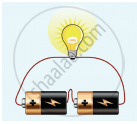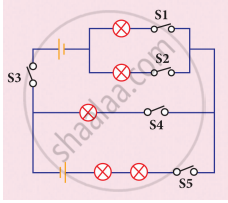Advertisements
Online Mock Tests
Chapters
![Samacheer Kalvi solutions for Science - Term 2 [English] Class 7 TN Board chapter 2 - Electricity Samacheer Kalvi solutions for Science - Term 2 [English] Class 7 TN Board chapter 2 - Electricity - Shaalaa.com](/images/science-term-2-english-class-7-tn-board_6:5f2b1b2038084cf381bfa42c826a928c.jpg)
Advertisements
Solutions for Chapter 2: Electricity
Below listed, you can find solutions for Chapter 2 of Tamil Nadu Board of Secondary Education Samacheer Kalvi for Science - Term 2 [English] Class 7 TN Board.
Samacheer Kalvi solutions for Science - Term 2 [English] Class 7 TN Board 2 Electricity Evaluation [Pages 32 - 34]
Choose the correct answers
In the circuit diagram below, 10 units of electric charge move past point x every second What is the current in the circuit ______.

10 A
1 A
10 V
1 V
In the circuit shown, which switches (L,M or N) must be closed to light up the bulb?

switch L only
switch M only
Switch M and N only
either switch L or switches M and N
Small amounts of electrical current are measured in milliampere (mA). How many milliampere are there in 0.25 A ?
2.5 mA
25 mA
250 mA
2500 mA
In which of the following circuits are the bulb connected in series?
Fill in the blanks.
The direction of conventional current is ______ to electron flow.
One unit of coulomb is charge of approximately ______ protons or electrons.
______ is used to measure the electric current.
In conducting materials electrons are ______ bounded with atoms.
S.I. unit of Electrical conductivity of a conductor is ______.
True or False – If False give the correct answer
Electron flow is in the same direction to conventional current flow.
True
False
True or False – If False give the correct answer
The fuse wire does not melts whenever there is overload in the wiring.
True
False
True or False – If False give the correct answer
In a parallel circuit, the electric components are divided into branches.
True
False
True or False – If False give the correct answer
The representation of the electric current is A
True
False
True or False – If False give the correct answer
The electrical conductivity of the semiconductor is in between a conductor and an insulator.
True.
False
Match the following
| 1. | Cell | used to open or close a circuit |
| 2. | Switch | safety device used in electric circuit |
| 3. | Circuit | A complete path for the flow of an electric current |
| 4. | Miniature circuit Breaker | Reset by hand, circuit becomes complete once again |
| 5. | Fuse | A device which converts chemical energy into electrical energy |
Analogy
Water : pipe :: Electric current : ______.
Copper: conductor:: Wood: ______.
Length: metre scale: : Current: ______
milli ampere: micro ampere : : 10-3A : ______.
Assertion and Reason
Assertion (A): Copper is used to make electric wires.
Reason (R): Copper has very low electrical resistance.
Both A and R are true and R is the correct explanation of A.
Both A and R are true but R is NOT the correct explanation of A.
A is true but R is false.
A is false but R is true.
Both A and R are false
Assertion (A): Insulators do not allow the flow of current through themselves.
Reason (R): They have no free charge carriers.
If both A and R are true and the R is correct explanation of A.
If both A and R are true but R is not a correct explanation of A.
If A is true and R is false.
If both A and R are false.
Very short answer
What is the speed of electric current?
What is the S.I unit of electrical conductivity?
Name the device used to generate electricity.
Define fuse.
Name some devices that run using heat effect of electric current
Name few insulators.
What is a battery?
Short Answer
Define an electric current.
Differentiate parallel and serial circuits.
Define electrical conductivity.
Long Answer
Explain the construction and working of an Telephone.
Explain the heating effect of electric current.
Explain the construction and working of a dry cell.
Higher Order Question
A student made a circuit by using an electric cell, a switch, a torch bulb (fitted in the bulb holder), and copper connecting wires. When he turned on the switch, the torch bulb did not glow at all. The student checked the circuit and found that all the wire connections were tight.
- What could be the possible reason for the torch bulb not glowing even when the circuit appears to be complete?
Picture based Question
Three conductors are joined as shown in the diagram
The current in conductor RS is 10 A. The current in conductor QR is 6 A. What will be the current in conductor PR
- 4 A
- 6 A
- 10 A
- 16 A

Draw the circuit diagram for the following series connection

Study the electric circuit below. Which of the following switches should be closed so that only two bulbs will light up

S1,S2 and S4 only
S1, S3 and S5 only
S2, S3 and S4 ony
S2, S3 and S5 only
Study the three electric circuits below. Each of them has a glass rod (G), a steel rod (S), and a wooden rod (W).
In which of the electric circuits would the bulb not light up.

A only
C only
A and B only
A , B and C
Solutions for 2: Electricity
![Samacheer Kalvi solutions for Science - Term 2 [English] Class 7 TN Board chapter 2 - Electricity Samacheer Kalvi solutions for Science - Term 2 [English] Class 7 TN Board chapter 2 - Electricity - Shaalaa.com](/images/science-term-2-english-class-7-tn-board_6:5f2b1b2038084cf381bfa42c826a928c.jpg)
Samacheer Kalvi solutions for Science - Term 2 [English] Class 7 TN Board chapter 2 - Electricity
Shaalaa.com has the Tamil Nadu Board of Secondary Education Mathematics Science - Term 2 [English] Class 7 TN Board Tamil Nadu Board of Secondary Education solutions in a manner that help students grasp basic concepts better and faster. The detailed, step-by-step solutions will help you understand the concepts better and clarify any confusion. Samacheer Kalvi solutions for Mathematics Science - Term 2 [English] Class 7 TN Board Tamil Nadu Board of Secondary Education 2 (Electricity) include all questions with answers and detailed explanations. This will clear students' doubts about questions and improve their application skills while preparing for board exams.
Further, we at Shaalaa.com provide such solutions so students can prepare for written exams. Samacheer Kalvi textbook solutions can be a core help for self-study and provide excellent self-help guidance for students.
Concepts covered in Science - Term 2 [English] Class 7 TN Board chapter 2 Electricity are Electricity, Electric Current, Direction of the Electric Current - Conventional and Electronic Flow, Potential and Potential Difference, Electrical Resistivity and Electrical Conductivity, Resistance (R), Analogy of Electric Current with Water Flow, Electro Chemical Cells, Electric cell, Battery, Electric Switch, Electric Circuit, Types of Circuits: Series Circuit, Types of Circuits: Parallel Circuit, Similarity and Difference Between Series and Parallel Circuit, Precautions to Be Taken While Using Electricity, Conductors and Insulators, Effects of Electric Current, Heating Effect of Electric Current, Magnetic Effect of Electric Current, Chemical Effects of Electric Current.
Using Samacheer Kalvi Science - Term 2 [English] Class 7 TN Board solutions Electricity exercise by students is an easy way to prepare for the exams, as they involve solutions arranged chapter-wise and also page-wise. The questions involved in Samacheer Kalvi Solutions are essential questions that can be asked in the final exam. Maximum Tamil Nadu Board of Secondary Education Science - Term 2 [English] Class 7 TN Board students prefer Samacheer Kalvi Textbook Solutions to score more in exams.
Get the free view of Chapter 2, Electricity Science - Term 2 [English] Class 7 TN Board additional questions for Mathematics Science - Term 2 [English] Class 7 TN Board Tamil Nadu Board of Secondary Education, and you can use Shaalaa.com to keep it handy for your exam preparation.




